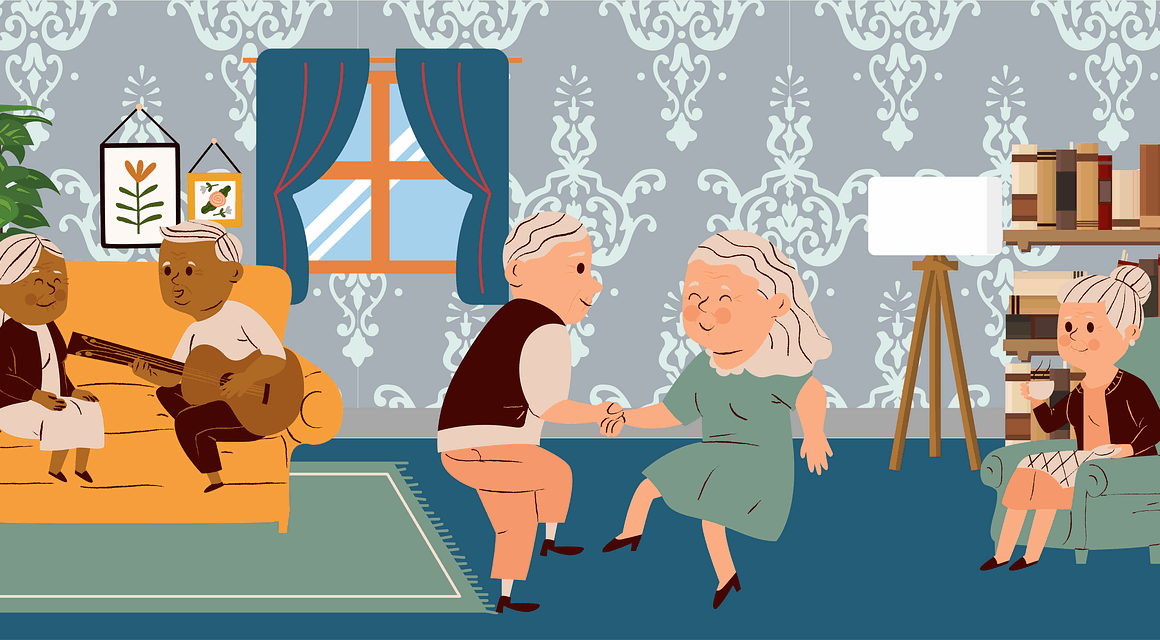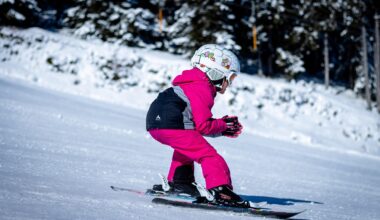Incorporating Stretching and Strength Training in Senior Dance Aerobics
Dance aerobics is an engaging way for seniors to stay active, combining fun movement with fitness benefits. One essential aspect is incorporating stretching and strength training into the routine. Stretching helps increase flexibility, essential for preventing injuries during aerobic activities. Flexibility decreases naturally with age, making stretching vital for seniors. By introducing gentle stretches before and after dance sessions, seniors can improve their range of motion. Additionally, it aids in muscle recovery, helping to alleviate soreness and stiffness following physical exertion. Strength training is also crucial, as it helps maintain muscle mass, bone density, and overall strength. Light resistance exercises using body weight or small hand weights can be included in the dance aerobics program. Quick sets of movements like squats or arm raises complement the aerobic routines effectively. Slowly increasing resistance over time ensures progress without overwhelming participants. Balancing these elements helps create a comprehensive dance aerobics experience tailored for seniors. Ultimately, the combination of stretching and strength training enhances the benefits of dance aerobics, ensuring seniors enjoy both fun and functional fitness. Engaging in these forms of exercise can lead to healthier, happier lifestyles.
Ensuring safety during senior dance aerobics is a top priority. Participants should always warm-up properly before starting any physical activity, particularly as they age. Warm-ups, including dynamic stretches, gradually increase heart rate and blood flow to the muscles, preparing the body for movement. Moreover, instructors should be aware of each participant’s fitness level and any medical conditions or limitations. Providing modifications for various exercises is essential, ensuring everyone feels comfortable while participating. Dance aerobics should be enjoyable yet challenging enough to keep seniors engaged. Incorporating interval training—alternating between moderate and higher intensity—can elevate heart rates effectively while accommodating all fitness levels. Another crucial aspect is choosing appropriate music that resonates with the participants, as it enhances enthusiasm and motivation. A good instructor will create an inviting atmosphere, fostering social interaction and camaraderie among participants. A sense of community is beneficial, encouraging seniors to sustain their fitness journey. Lastly, hydration should not be overlooked; seniors must drink enough water throughout the session to stay well-hydrated, especially during intense movements. This supportive environment prioritizes safety while promoting fitness and social connections within the class.
Motivating Seniors through Fun and Engagement
To enhance participation in dance aerobics, motivation is essential, particularly among seniors. Making fitness fun is key to their commitment to regular classes. Creative choreography that incorporates various music styles keeps the routine fresh and interesting. Instructors can also introduce themed classes, such as music from different decades or cultural dance styles, which helps seniors reconnect with fond memories. Some seniors may feel hesitant about joining a new class due to self-consciousness. Building self-confidence is crucial in overcoming these barriers. Gentle encouragement from instructors and fostering a non-competitive environment can help achieve this. Group dynamics play a significant role; when participants bond over shared experiences, their engagement increases. Group challenges, where seniors set and achieve goals together, can foster camaraderie and accountability. Instructors should celebrate collective achievements, facilitating positive reinforcement. Also, offering opportunities for participants to suggest music or styles they enjoy empowers seniors. In turn, this creates a class that resonates with their preferences, enhancing willingness to attend sessions. Overall, an enthusiastic atmosphere infused with creativity and participation strengthens commitment to dance aerobics in seniors.
Another vital element in senior dance aerobics is the consideration of individual health conditions. Many seniors may struggle with arthritis, osteoporosis, or other ailments requiring tailored exercise. Therefore, instructors must be knowledgeable about various conditions and possess the skills to adapt exercises accordingly. Low-impact movements are typically recommended for seniors, as they reduce stress on joints while providing cardiovascular benefits. Simple knee lifts, side steps, and gentle torso twists are excellent low-impact options for incorporating into dance routines. Slower transitions from one move to another help participants maintain proper form while preventing injuries. Additionally, utilizing chair workouts or seated options can provide alternatives for those with mobility challenges. This ensures that everyone can participate and enjoy the class. Listening and adjusting to individual needs is fundamental; instructors should pay close attention to symptoms and make necessary modifications when required. Moreover, regular communication with healthcare professionals can offer invaluable insights into developing safe exercise programs for older adults. Implementing these considerations ensures that the exercise experience is effective, enjoyable, and safe. By supporting seniors through tailored music and movements, the dance aerobics program becomes accessible and beneficial for all.
Creating an Appropriate Environment
The environment in which seniors participate in dance aerobics has a profound impact on their experience. Adequate space enhances movement freedom, allowing participants to focus without feeling cramped. Ideally, sessions should be conducted in well-ventilated, well-lit areas with appropriate flooring to ensure safety. A wooden or foam floor surface prevents slip-related accidents while allowing for safe dance movement. Furthermore, instructors should consider the temperature of the environment; maintaining a comfortable temperature is crucial for participants to engage fully. Additionally, incorporating visual cues such as mirrors can aid seniors in understanding proper movements and postures. Mirrors can help with body awareness, allowing participants to self-correct their form as needed. Furthermore, accessibility is vital; the venue should be easy to navigate for participants with mobility aids. Having seating areas available for rest can accommodate those who may require breaks during the session. A welcoming atmosphere fosters a sense of belonging for seniors participating in dance aerobics. Overall, investing in the right environment influences not only comfort but also the success of aerobic classes, ensuring participants feel secure and inspired.
Regular assessments of the dance aerobics program can identify areas for improvement. Seeking feedback from participants encourages instructors to understand their needs, preferences, and suggestions for the program. Anonymous surveys or informal conversations after classes can provide insight into what attendees enjoy and what could be adjusted. Listening to their opinions builds trust and an open line of communication between instructors and seniors. Additionally, keeping up with the latest trends in fitness for seniors ensures that classes stay relevant and appealing. Staying informed about new techniques, exercises, and health guidelines allows instructors to refine their programs continually. Incorporating new dance styles or innovative methods can also create excitement, drawing a larger audience. Moreover, a consistent schedule boosts participation rates, allowing seniors to expect classes regularly. Sharing progress updates or celebrating milestones as a group can reinforce a sense of achievement. Acknowledging accomplishments motivates persistence in routine participation. Providing continuous education for instructors enhances overall class quality. Attending workshops or networking within the fitness community is equally important to enrich class offerings. In conclusion, actively adapting the dance aerobics program ensures it remains engaging and valuable for senior participants.
Conclusion: Promoting Lifelong Fitness through Dance Aerobics
Incorporating stretching and strength training into senior dance aerobics revolutionizes exercise for older adults. By addressing the unique needs of this demographic, the program fosters not only physical fitness but also mental well-being. Dance aerobics encourages social interaction, reduces feelings of isolation, and enhances the overall quality of life for participants. Stretching promotes flexibility, while combined with strength training, helps seniors gain and maintain their independence. Keeping them strong enables participation in activities of daily living with ease. Furthermore, the joy of movement unlocked through dance invigorates seniors’ spirits, increasing satisfaction from exercise routines. The appeal of music serves as an emotional connector, reminding them of favorite times and experiences. As they sway, shuffle, and twirl, participants experience a sense of freedom which is both liberating and rewarding. These vibrant classes invite seniors to engage with their community, motivating healthier lifestyles that extend beyond the dance floor. Prioritizing fun and safety fosters long-term participation. By embracing dance aerobics, seniors can enjoy the journey towards enhanced health and well-being. In moving their bodies, they uncover the joy of maintaining an active lifestyle, enriching their lives through fitness.
As we reflect on the benefits of incorporating stretching and strength training into senior dance aerobics, it becomes evident that the journey toward a healthier lifestyle is attainable and enjoyable. Engaging in regular activity helps combat aging effects, creating a more vibrant and vital community of seniors. It is our responsibility to promote programs that encourage inclusivity and adaptability tailored to individual needs. By fostering an environment where seniors can connect, express themselves, and challenge their capabilities, we support their growth. A more active lifestyle paves the way for reduced risks of chronic diseases, contributing to overall longevity. Additionally, involving healthcare professionals in discussions surrounding exercise regimens offers essential insights, motivating seniors to embrace physical activity confidently. The collaboration between fitness instructors and health experts ensures that each session meets participant requirements effectively. As we close this discussion, it’s vital to advocate for awareness and accessibility to dance aerobics programs in local communities. By doing so, we can help build a foundation for lifelong engagement in fitness among seniors. Together, let’s dance towards a future where health and wellness are prioritized, and every senior can enjoy the rewards of movement.


